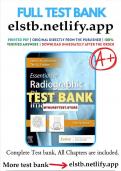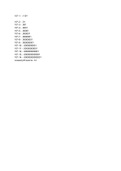-
1. Examen - Test bank: journey across the life span: human development and health promotion( elai...
-
2. Examen - The test bank for essentials of human anatomy and physiology 13th edition marieb ques...
-
3. Examen - Test bank for success in practical vocational nursing from student to leader, 10th ed...
-
4. Examen - Test bank for anatomy and physiology the unity of form and function 10th edition by k...
-
5. Examen - Test bank for fundamentals of nursing 10th edition by by carol taylor, pamela lynn & ...
-
6. Examen - Test bank for critical care nursing diagnosis and management 9th edition by linda d. ...
-
7. Examen - Test bank for evidence-based physical examination best practices for health & well-be...
-
8. Examen - Test bank lehne’s pharmacotherapeutics for advanced practice nurses and physician a...
-
9. Examen - Test bank - nursing in today's world: trends, issues, and management, 12th edition (b...
-
10. Examen - Test bank - applied pharmacology for veterinary technicians, 6th edition (martini-joh...
-
11. Examen - Test bank - community and public health nursing: evidence for practice 4th edition by...
-
12. Examen - Test bank for gould's pathophysiology for the health professions 7th edition by karin...
-
13. Examen - Test bank for current medical diagnosis and treatment 2024|25, 63rd edition by maxine...
-
14. Examen - Test bank for microbiology, a systems approach, 6th edition, marjorie kelly cowan, he...
-
15. Examen - Test bank for organizational behavior: an evidence-based approach 13th edition by lut...
-
16. Examen - Test bank for safe maternity & pediatric nursing care 2nd edition by luanne linnard-p...
-
17. Examen - Test bank for keltne's psychiatric nursing 9th edition by debbie steele , isbn: 97803...
-
18. Examen - Test bank - bates guide to physical examination and history taking, 13th edition (bic...
-
19. Examen - Test bank for concepts for nursing practice (3rd ed) by jean giddens| complete guide ...
-
20. Examen - Anthony’s textbook of anatomy & physiology 21st edition patton test bank
-
21. Examen - Test bank for kaplan and sadocks synopsis of psychiatry edition 12 all chapters with ...
-
22. Examen - Test bank - for the psychiatric interview fifth edition( author: daniel j. carlat, 20...
-
23. Examen - Test bank for -principles of auditing and other assurance services 22nd edition by ra...
-
24. Examen - Test bank - chemistry: the central science, 15th edition (brown, 2018), chapter 1-24 ...
-
25. Examen - Test bank for foundations for population health in community public health nursing 5t...
-
26. Examen - Test bank for critical care nursing- a holistic approach, 12th edition by morton font...
-
27. Examen - Test bank for multinational business finance 16th edition by (eiteman/stonehill/moffe...
-
28. Examen - Test bank for davis advantage for pathophysiology introductory concepts and clinical ...
-
29. Examen - Test bank - lehne's pharmacology for nursing care, 12th edition ( jacqueline burchum,...
-
30. Examen - Test bank for pharmacotherapeutics for advanced practice- a practical approach 5th ed...
-
31. Examen - Test bank: varcarolis' foundations of psychiatric-mental health nursing a clinical 9t...
-
32. Examen - Fundamentals of nursing 10th edition test bank
-
33. Examen - Test bank for lehne's pharmacology for nursing care, 11th edition by jacqueline burch...
-
34. Examen - Test bank for community and public health nursing evidence for practice3rd edition by...
-
35. Examen - Test bank - lpn to rn transitions 5th edition by lora claywell
-
36. Examen - Test bank for craven & hirnle's fundamentals of nursing concepts and competencies for...
-
37. Examen - Test bank wong's nursing care of infants and children (12th) by marilyn j. hockenberr...
-
38. Examen - Test bank for davis advantage for medical-surgical nursing: making connections to pra...
-
39. Examen - Test bank -professional nursing: concepts & challenges, 10th edition by: beth black p...
-
40. Examen - Test bank for pharmacology clear and simple: a guide to drug classifications and dosa...
-
41. Examen - Test bank for essentials of nursing leadership & management 8th edition 2024, by sall...
-
42. Examen - Test bank for gerontological nursing 10th edition by eliopoulos
-
43. Examen - Test bank for gerontological nursing 10th edition by eliopoulos
-
44. Examen - Test bank for leadership roles and management functions in nursing theory and applica...
-
45. Examen - Complete test bank ecology 5th edition bowman questions & answers with rationales (ch...
-
46. Examen - Test bank for -physical examination and health assessment 9th edition by carolyn jarv...
-
47. Examen - Test bank for maternal child nursing care, 7th edition by shannon e. perry, marilyn j...
-
48. Examen - Test bank for porth's pathophysiology concepts of altered health states 11th edition ...
-
49. Examen - Test bank for pathophysiology 7th edition by jacquelyn l. banasik chapter 1-54|comple...
-
50. Examen - Test bank : communication in nursing, 10th edition, 10th edition (julia balzer riley ...
-
51. Examen - Test bank - stanhope and lancasters community health nursing in canada, 4th edition (...
-
52. Examen - Psychiatric-mental health nursing 9th edition by videbeck test bank
-
53. Examen - Test bank concepts for nursing practice (3rd ed) by jean giddens 2024 stuvia
-
54. Examen - Solution manual for statistics for nursing research a workbook for evidence-based pra...
-
55. Examen - Test bank fortimby's introductory medical-surgical nursing, 13th edition(donnelly-mor...
-
56. Examen - Test bank for timby's fundamental nursing skills and concepts, 12th edition by lorett...
-
57. Examen - Test bank for maternal-child nursing 6th edition by emily slone mckinney | all chapte...
-
58. Examen - Test bank for davis advantage for basic nursing: thinking, doing, and caring 3rd edit...
-
59. Examen - Test bank for nutrition for healthy living 6th edition schiff all chapters 1-13 full ...
-
60. Examen - Test bank - biochemistry, 9th edition (berg and stryer, 2020), chapter 1-36 | all cha...
-
61. Examen - Test bank ; davis advantage for psychiatric mental health nursing 10th edition{ by ka...
-
62. Examen - Porth's essentials of pathophysiology 5th edition test bank by tommie l norris all ch...
-
63. Examen - Test bank for fundamentals of nursing 11th edition potter perry chapter 1-50 |complet...
-
64. Examen - Test bank for chemistry and physics for nurse anesthesia 3rd edition by david shubert...
-
65. Examen - Advanced assessment: interpreting findings and formulating differential diagnoses 5th...
-
66. Examen - Test bank for nursing now: today's issues, tomorrow's trends, 9th edition by joseph c...
-
67. Examen - Tcar-post test real exam questions and correct answers already graded a+ 1. helmets a...
-
68. Examen - Test bank for nursing now: today's issues, tomorrow's trends, 8th edition by joseph c...
-
69. Examen - Test bank for canadian organizational behaviour 11th edition by steven mcshane, kevin...
-
70. Examen - Test bank - pharmacotherapeutics for advanced practice nurse prescribers, 6th edition...
-
71. Examen - Test bank for medical surgical nursing 5th edition by holly k. stromberg, all chapter...
-
72. Examen - Test bank - polit and beck canadian essentials of nursing research, 4th edition (woo,...
-
73. Examen - Complete test bank brock biology of microorganisms 16th edition madigan questions & a...
-
74. Examen - Essentials of pediatric nursing 4th edition by kyle carman test bank | all chapter 1 ...
-
75. Examen - 21st century maternity and women’s health nursing lowdermilk: maternity & women’s...
-
76. Examen - Camilla franklin i-human case study | 48-year-old with fatigue and irritability | lat...
-
77. Examen - Complete test bank essentials of radiographic physics and imaging 3rd edition johnsto...
-
78. Examen - Introductory clinical pharmacology 12th edition susan m ford test bank all chapters (...
-
79. Examen - Test bank for miller's nursing for wellness in older adults, canadian edition sandra ...
-
80. Examen - Test bank for child development 9th edition by laura e. berk
-
Mostrar más





